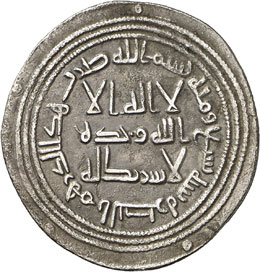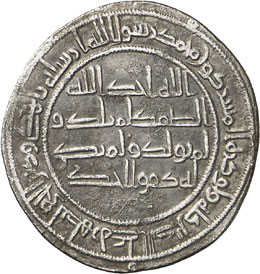- Home
- Vente aux enchères 8
- 245 THE UMAYYAD DYNASTY, AH 41-132 (661-750). AN EXTRAORDINARY ...
Lot 245 - Vente aux enchères 8
Bids
Description
This previously unrecorded coin from al-Basra is an extraordinary discovery, because it fits neatly with another unique dirham of al-Kufa dated AH 108 (Klat 547, 1 reference) and provides an interesting glimpse into the political situation in Iraq during the governorship of Khalid bin ‘Abd Allah al-Qasri, who occupied a position analogous to that of al-Hajjaj bin Yusuf, a previous governor and principal advisor to the Caliph ‘Abd al-Malik. What can this coin tell us? First of all, the pattern of five single annulets found in the obverse margin are not those that appeared on Khalid’s coins while he was governor of Iraq and master of the mint in Wasit. Those coins placed three double annulets in the obverse margin so that they could be easily distinguished from coins from the mints that did not lie under his jurisdiction. Khalid was particularly insistent that all Iraqi mint activity should be centralised in Wasit. These two coins of al-Kufa and al-Basra provide evidence that there must have been civil unrest in the province during these years and it is no surprise that the two cities appear to have been the traditional focal points for unrest in southern Iraq. Both mints had been reopened by the Caliph ‘Umar II bin ‘Abd al-‘Aziz in the year AH 100 and both were closed three years later by Yazid II bin ‘Abd al-Malik, and it is likely that both cities felt slighted by the loss of their prestigious mints. The Wasit mint was active in the years 108 and 109, which provides evidence that Wasit continued to be under Khalid’s control. Chronicles that do not provide firm dates mention the unrest in Iraq during Khalid’s governorship, which can now, thanks to these two coins, be narrowed down to at least the years AH 108 and 109. The extreme rarity of both pieces suggests that additional rebel coinages may eventually be identified.
Please use the registration form to send us your participation request, or, if you are already registered and authorized, use the login box on the top.
For any information please contact auction@ngsa.ch
Vente aux enchères 8
Categories
Auction: Vente aux enchères 8
- Celtic Coins
- Greek Coins
- Roman Republic
- Roman Empire
- Byzantine Empire
- The Islamic World
- Albania
- Germany
- Annam
- Holy Roman Empire/Austria
- Belgium
- Cambodia
- Chile
- China
- Denmark
- Spain
- Ethiopia
- France
- French colonial coins
- Great Britain
- Greece
- Crete
- Guatemala
- Holland/Nederlands
- Hungary
- Danish India
- Italy
- Luxembourg
- Mexico
- Monaco
- Montenegro
- Poland
- Portugal
- Russia
- Serbia/Yugoslavia
- Sweden
- Switzerland
- Transylvania
- USA
Timetable
Pre-bidding - End
23 11 2014 16:00 CET
Room auction - Start
24 11 2014 14:00 CET
Live auction - Start
24 11 2014 15:00 CET
Contacts
Rond-point de Plainpalais 1, Ginevra, Genève, Switzerland
 Respecting your privacy is our priority
Respecting your privacy is our priority
This site uses cookies to improve user experience and to collect information on the use of the site. You can read our cookie policy, accept all cookies and continue browsing by clicking on "Accept" or customize your choice by clicking on "Customize".
Cookie Policy
Cookies
To make this site work properly, we sometimes install small data files called "cookies " on your device. Most of the big sites do the same.
What are cookies?
A cookie is a small text file that websites save on your computer or mobile device while you visit them. Thanks to cookies, the site remembers your actions and preferences (for example login, language, font size and other display settings) so that you do not have to re-enter them when you return to the site or browse from one page to another.
How do we use cookies?
Third party cookies
Google Analytics
This site uses Google Analytics to collect information about the use of users of its website. Google Analytics generates statistical and other information through cookies, stored on users' computers. The information generated relating to our website is used to make reports on the use of websites. Googl
How to control and modify cookies?
You can modify or withdraw your consent at any time from the cookie declaration on our website.
Privacy Policy
Find out more about who we are, how you can contact us and how we process personal data in our privacy policy .
The necessary cookies help to make the website usable by enabling basic functions such as page navigation and access to protected areas of the site. The website cannot function properly without these cookies.
| Name | Supplier | Purpose | Expiry |
|---|---|---|---|
| cookieConsent | Bid Inside | Stores the user's cookie consent status for the current domain | 6 months |
| PHPSESSID | Bid Inside | Preserve the user's status in the different pages of the site. | When the browsing session ends |
| f_display | Bid Inside | The f_display cookies memorize the display mode chosen by the user in the pages where there are lists | When the browsing session ends |
| f_page | Bid Inside | The f_page cookies store the page viewed by the user in the pages where there are lists | When the browsing session ends |
| f_rec_page | Bid Inside | The f_rec_page cookies store the number of elements to be displayed per page chosen by the user in the pages in which there are lists | When the browsing session ends |
| f_order_by | Bid Inside | The f_order_by cookies store the sorting parameter selected by the user in the pages where there are lists | When the browsing session ends |
| f_order_dir | Bid Inside | The f_order_dir cookies store the ordering direction chosen by the user in the pages where there are lists | When the browsing session ends |
| watch_list_show_imgs | Bid Inside | The watch_list_show_imgs cookie stores the user's choice to show or hide lot images on the watch list page | When the browsing session ends |
| selected_voice | Bid Inside | The selected_voice cookie stores the voice selected by the user for the speech synthesis present in the live auction | 1 Month |
| include_autobids | Bid Inside | The include_autobids cookie stores the user's choice to show or hide their auto-bids on the 'Your bids' page | 6 months |
Analytical cookies help to understand how visitors interact with the website, collecting and transmitting statistical information to the Data Controller.
| Name | Supplier | Purpose | Expiry |
|---|---|---|---|
| _ga | Register a unique ID used to generate statistical data on how the visitor uses the website. | 2 years | |
| _gat_gtag | Used by Google Analytics to limit the frequency of requests | 1 day | |
| _gat | Used by Google Analytics to limit the frequency of requests | 1 day | |
| _gid | Register a unique ID used to generate statistical data on how the visitor uses the website. | 1 day | |
| __utma | Bid Inside | Used to distinguish users and sessions. The cookie is created when the javascript library executes and no existing __utma cookies exists. The cookie is updated every time data is sent to Google Analytics. | 2 years |
| __utmt | Bid Inside | Used to throttle request rate. | 10 minutes |
| __utmb | Bid Inside | Used to determine new sessions/visits. The cookie is created when the javascript library executes and no existing __utmb cookies exists. The cookie is updated every time data is sent to Google Analytics. | 30 minutes |
| __utmc | Bid Inside | Not used in ga.js. Set for interoperability with urchin.js. Historically, this cookie operated in conjunction with the __utmb cookie to determine whether the user was in a new session/visit. | When the browsing session ends |
| __utmz | Bid Inside | Stores the traffic source or campaign that explains how the user reached your site. The cookie is created when the javascript library executes and is updated every time data is sent to Google Analytics. | 6 months |
| __utmv | Bid Inside | Used to store visitor-level custom variable data. This cookie is created when a developer uses the _setCustomVar method with a visitor level custom variable. This cookie was also used for the deprecated _setVar method. The cookie is updated every time data is sent to Google Analytics. | 2 years |
Preference technical cookies allow a website to remember information that affects the way the site behaves or presents itself, such as your preferred language or the region you are in.
We do not use cookies of this type.Profiling cookies are used for marketing purposes, to monitor website visitors. The intent is to display relevant and engaging ads for the individual user.
We do not use cookies of this type.Unclassified cookies are cookies that are being classified, together with individual cookie providers.
We do not use cookies of this type.





 246
246